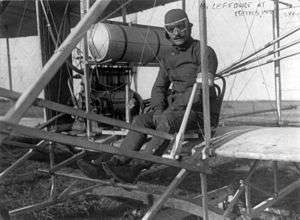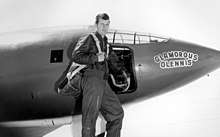Test pilot
A test pilot is an aircraft pilot with additional training to fly and evaluate experimental, newly-produced and modified aircraft with specific maneuvers, known as flight test techniques.[2]

.jpg)

In the 1950s, test pilots were being killed at the rate of about one a week, but the risks have shrunk to a fraction of that because of the maturation of aircraft technology, better ground-testing and simulation of aircraft performance, fly-by-wire technology and, lately, the use of unmanned aerial vehicles to test experimental aircraft features. Still, piloting experimental aircraft remains more dangerous than most other types of flying.
Qualifications
- Understand a test plan
- Stick to a test plan by flying a plane in a highly specific way
- Carefully document the results of each test
- Have an excellent feel for the aircraft and sense exactly how it is behaving oddly if it is doing so
- Solve problems quickly if anything goes wrong with the aircraft during a test
- Cope with many different things going wrong at once
- Effectively communicate flight test observations to engineers and relate engineering results to the pilot community, thus bridging the gap between those who design and build aircraft with those who employ the aircraft to accomplish a mission
- Have an excellent knowledge of aeronautical engineering to understand how and why planes are tested.
- Be above-average pilots with excellent analytical skills and the ability to fly accurately while they follow a flight plan.
Test pilots can be experimental and engineering test pilots (investigating the characteristics of new types of aircraft during development) or production test pilots (the more mundane role of confirming the characteristics of new aircraft as they come off the production line). Many test pilots would perform both roles during their careers. Modern test pilots often receive formal training from highly-selective military test pilot schools, but other test pilots receive training and experience from civilian institutions and/or manufacturers' test pilot development programs.
History
Test flying as a systematic activity started during the First World War, at the Royal Aircraft Establishment (RAE) in the United Kingdom. An "Experimental Flight" was formed at the Central Flying School. During the 1920s, test flying was further developed by the RAE in the UK, and by the National Advisory Committee for Aeronautics (NACA) in the United States. In the 1950s, NACA was transformed into the National Aeronautics and Space Administration, or NASA. During these years, as work was done into aircraft stability and handling qualities, test flying evolved towards a more qualitative scientific profession. At the insistence of President Dwight D. Eisenhower, the first American astronauts, the Mercury Seven, were all military test pilots, as were some of the later astronauts.
The world's oldest test pilot school is what is now called the Empire Test Pilots' School (motto "Learn to Test - Test to Learn"), at RAF Boscombe Down in the UK. There are a number of similar establishments over the world. In America, the United States Air Force Test Pilot School is located at Edwards Air Force Base, the United States Naval Test Pilot School is located at Naval Air Station Patuxent River, Maryland and EPNER (Ecole du Personnel Navigant d'Essai et de Reception - "School for flight test and acceptance personnel"), the French test pilot school, is located in Istres, France. The only civilian school in the United States is the National Test Pilot School, a not-for-profit educational institute located in Mojave, California. In Russia, there is a Russian aviation industry Fedotov Test Pilot School (founded 1947)[3] located in Zhukovsky within the Gromov Flight Research Institute.
Notable test pilots
- Bert Acosta
- Sergei Anokhin
- Michael T. Alsbury
- Scott D. Anderson
- Neil Armstrong
- Roland Beamont
- Bill Bedford
- Charles F. Bolden, Jr.
- Vance Brand
- Bill Bridgeman
- Eric "Winkle" Brown
- Scott Carpenter
- Albert Scott Crossfield
- Eugene Cernan
- John Cunningham
- Geoffrey de Havilland, Jr.
- John Derry
- Desmond 'Dizzy' de Villiers
- Heini Dittmar
- Neville Duke
- Einar Enevoldson
- John Farley
- Yuri Garnaev
- John Glenn
- Chalmers Goodlin
- Mikhail Gromov
- Boone Guyton
- Chris Hadfield
- Harry Hawker
- Hedley Hazelden
- Bob Hoover
- Howard Hughes
- Bill Humble
- "Tex" Johnston
- Anatoly Kvochur
- Robert Henry Lawrence, Jr.
- Léon Lemartin
- Anatoli Levchenko
- Tony LeVier
- Jim Lovell
- George Marrett
- Mike Melvill
- John Lankester Parker
- Timothy Peake
- Alexey Perelet
- Marina Popovich
- John Cyril Porte
- Jeffrey Quill
- Lars Rådeström
- Hanna Reitsch
- Ewald Rohlfs
- Thomas Rose[4]
- Dick Rutan
- Jacques Rosay
- Gerry Sayer
- Wally Schirra
- Rakesh Sharma
- Alan Shepard
- Rimantas Stankevičius
- Amet-khan Sultan
- Mutt Summers
- Richard G. Thomas
- Brian Trubshaw
- Andre Turcat
- Joseph John "Tym" Tymczyszyn
- Pavel Vlasov
- Igor Volk
- Joseph A. Walker
- Erich Warsitz
- George Welch
- Fritz Wendel
- Chuck Yeager
- John Young
- Janusz Żurakowski
See also
References
- Léon Lemartin (Ai. 1899)
- Stinton, Darrol. Flying Qualities and Flight Testing of the Airplane. American Institute of Aeronautics and Astronautics, Inc., 1996, p. 265
- Знаменская, Наталья, ed. (2002). ШЛИ со временем [ShLI in Time] (in Russian) (2 ed.). Жуковский: ООО "Редакция газеты "Жуковские вести". p. 400.
- Miles Aircraft
- Hallion, Richard P.Test Pilots: Frontiersmen of Flight. Washington, DC: Smithsonian Press, 1988. ISBN 978-0874745498
- Warsitz, Lutz: THE FIRST JET PILOT - The Story of German Test Pilot Erich Warsitz, Pen and Sword Books Ltd., England, 2009, ISBN 978-1-84415-818-8
External links
![]()